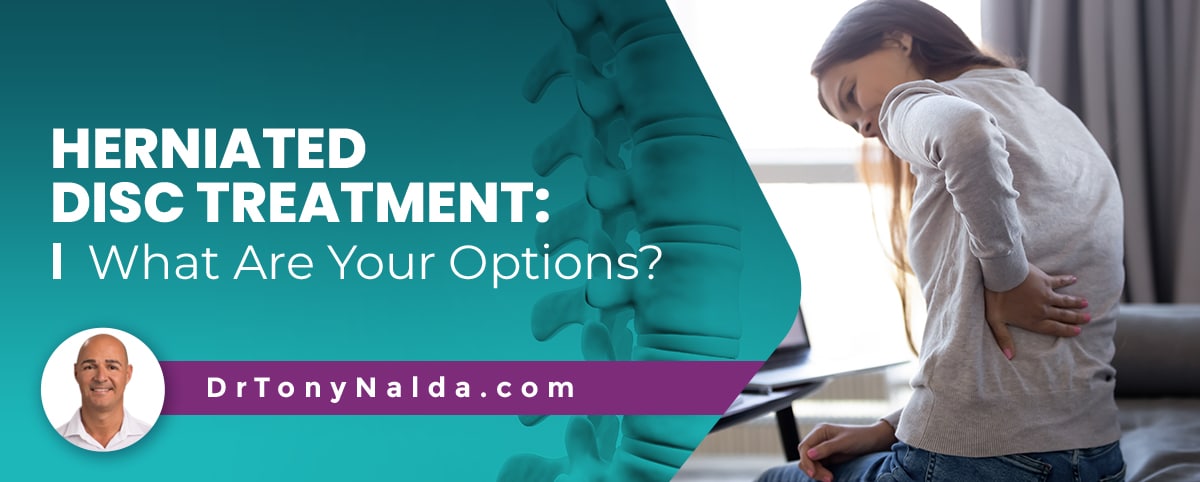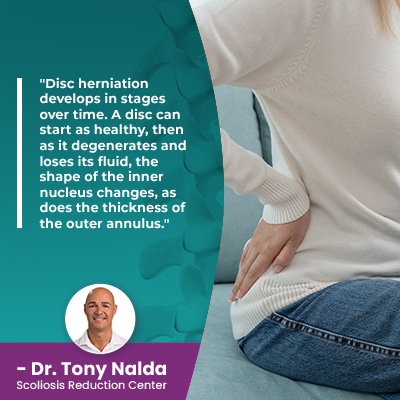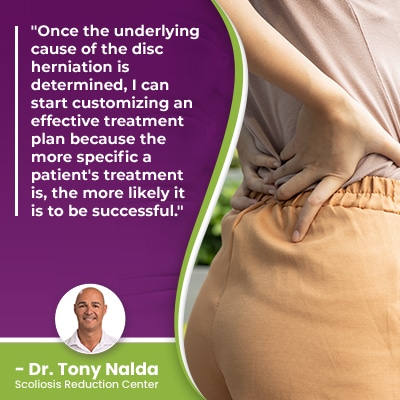Herniated Disc Treatment: What Are Your Options?

The spine's vertebrae are separated by intervertebral discs, and these discs perform a number of key functions that help the spine stay strong, flexible, and able to evenly absorb and distribute mechanical stress. When the discs start to deteriorate, it can cause a number of spinal conditions/issues to develop.
The spine's intervertebral discs are key to its ability to maintain healthy spinal curves and alignment. Disc herniation means a disc's inner nucleus has pushed through a tear in its outer annulus, and now the nucleus is encroaching on space within and around the spine.
As the spinal discs are so important for a healthy spine, let's take a look at the structure of a healthy spine.
Table of Contents
Understanding a Healthy Spine
What makes a spine healthy is its ability to stay strong, flexible, and function as it was designed, and in order for that to happen, the spine needs to have its healthy curves and alignment in place.
The spine is curved at each of its main sections, and this makes it stronger, more flexible, and able to handle mechanical stress, like a coiled spring.
A healthy spine has its vertebrae (bones) stacked on top of one another in a straight and neutral alignment, and this means its curves are in place, but if one or more vertebrae shift out of alignment with the rest of the spine, the biomechanics of the entire spine are disrupted.
Adjacent vertebrae are separated by an intervertebral disc, and if a disc starts to degenerate, it can become a bulging disc and then a herniated disk, so let's take a look at the structure of the spine's intervertebral discs.
Intervertebral Discs
The spine's intervertebral discs consist of two main structures: a soft gel-like interior known as the nucleus and a tough durable outer layer known as the annulus.
The discs are made of collagen, proteoglycans, and water, and when we're born, the discs are made of approximately 80-percent water, but as we age, fluid is lost, and if there is an excessive loss of fluid, a disc can become desiccated.
The discs of the spine provide it with structure (adjacent vertebrae attach to the disc in between), act as the spine's shock absorbers, combine forces to enable flexibility, and act as the spine's shock absorbers.
When the spine starts to face natural age-related spinal degeneration, it's most often the spinal discs that are the first structures to start to deteriorate, and this is partially because the discs don't have their own vascular supply.
There is no direct path in and out of the discs through which nutrients and oxygen can flow to help with healing and hydrating the discs; instead, they use a process akin to osmosis to absorb what they can from their surroundings.
So how does a disc turn into a bulging, and then a herniated disk?
What's a Bulging Disc?
A bulging disc occurs when the disc's inner nucleus is pushing outwards against its outer annulus, causing it to bulge outwards around its perimeter, and this can cause a number of issues, including compression of nearby nerves as the extra bulge is putting pressure on a spinal nerve.
Now, as mentioned, discs lose their fluid levels as we age, and if a disc becomes desiccated, it will change shape, as happens when the nucleus is pushing outwards against the annulus.
If the disc's new shape means a nearby spinal nerve is being exposed to uneven pressure (compression), this can cause a number of symptoms.
In general, with most spinal conditions, the area of the body located closest to the affected disc and spinal section is going to be where the majority of the condition's direct effects are going to be felt.
So if a disc is bulging in the neck, it's going to affect the neck and its surroundings by causing neck pain, back pain, and sensations of numbness or tingling due to nerve roots being compressed.
If a disc is bulging in the thoracic spine, it's going to affect the middle/upper back and cause back pain, muscle pain, and spinal nerve inflammation can cause a number of symptoms and sensations.
If a disc is bulging in the lumbar spine, a common complication is the development of sciatic nerve pain because the sciatic nerve starts in the lumbar spine, so if a disc is bulging out and compressing/irritating/impinging the sciatic nerve, sciatica can develop.
Now, if a bulging disc is left untreated, it can become a herniated disk.
What's a Herniated Disk?
 So we've defined a bulging disc, which is the precursor of disc herniation because over time, that nucleus pushing outwards against the annulus is going to cause a tear, and then the inner nucleus is going to spill out of that tear, and encroach even further into the space around the disc and within the spine, and that space is needed by the surrounding nerve roots.
So we've defined a bulging disc, which is the precursor of disc herniation because over time, that nucleus pushing outwards against the annulus is going to cause a tear, and then the inner nucleus is going to spill out of that tear, and encroach even further into the space around the disc and within the spine, and that space is needed by the surrounding nerve roots.
Symptoms of a herniated disk can include back or neck pain, leg pain, bladder or bowel issues, low back pain, difficulty standing or walking for long periods of time, pain numbness, and radiating pain and sensations felt throughout the body due to nerve roots being compressed.
A herniated disk can also be referred to as a slipped or ruptured disk.
Disc herniation develops in stages over time. A disc can start as healthy, then as it degenerates and loses its fluid, the shape of the inner nucleus changes, as does the thickness of the outer annulus.
As the nucleus starts to push outwards against the tough outer layer, this is called prolapse, and once the inner nucleus has pushed its way to the outer annulus's edge, this is called extrusion, and sequestration has happened once the nucleus pushes through a tear in the annulus and projects into the vertebral space.
Disc herniation occurs in stages, starting with a healthy and hydrated disc which, as it starts to degenerate, can change the shape of the nucleus within and the thickness of the outer annulus.
While some don't experience noticeable symptoms of a herniated disk, others can experience mild and intermittent symptoms, or chronic and debilitating back and nerve pain.
In addition, the location and cause of a herniated disk, along with how much nerve involvement there is, factors into the types, and severity, of symptoms a patient is likely to experience.
Common symptoms of a herniated disk include arm and/or leg pain, numbness and tingling sensations, varying levels of back pain and mobility issues.
Herniated Disk Treatment
When it comes to treating a herniated disk, there are different treatment options available, and while surgery is always an option, spinal surgery is risky and invasive, and non-surgical treatment can also address a herniated disc.
Here at the Scoliosis Reduction Center, I've treated a wide range of spinal conditions non-surgically, disc herniation included.
Once the underlying cause of the disc herniation is determined, I can start customizing an effective treatment plan because the more specific a patient's treatment is, the more likely it is to be successful.
While I can never give treatment guarantees, the sooner treatment is started, the better, particularly when spinal degeneration is a factor.
One of the most common types of nonsurgical treatment include prescription medications and injections, and this can include anti inflammatory drugs to help strengthen the affected area by reducing swelling and providing pain relief, and steroid injections guided by ultrasound, but these are more short-term solutions.
Through a comprehensive physical examination, including taking the patient's family and medical history and looking at pertinent lifestyle factors, orthopedic and neurological testing, and MRI imaging, I can craft a 100-percent customized treatment plan.
 Lifestyle guidance can be an important facet of treatment as carrying excess weight, leading a sedentary lifestyle, not staying hydrated, chronic poor posture, and repeatedly lifting heavy objects incorrectly can increase natural age-related rates of disc degeneration.
Lifestyle guidance can be an important facet of treatment as carrying excess weight, leading a sedentary lifestyle, not staying hydrated, chronic poor posture, and repeatedly lifting heavy objects incorrectly can increase natural age-related rates of disc degeneration.
Through physical therapy and exercise that's condition-specific, a patient can start the recovery process and experience pain relief, and relief from a number of other symptoms such as mobility issues.
Additional therapies such as massage, heat, electric stimulation, and stretching can also help relieve pain.
Condition-specific chiropractic care uses gentle low-force techniques to treat a herniated disk
As a scoliosis chiropractor, I have a vast amount of experience treating a variety of spinal conditions and issues, disc herniation included, and chiropractic care uses precise and gentle low-force techniques to treat herniated discs.
Manual adjustments can help by relieving pressure on the spinal cord and spinal nerves, and flexion-distraction involving the use of a specialized table that gently stretches the spine, through a pumping rhythm, so I can isolate the affected area and concentrate my treatment efforts precisely.
While the spine is being gently pumped around the affected area, it encourages the nucleus to reclaim its central position inside the disc, which can restore disc height, and in addition, if the disc moves away from a compressed nerve, nerve inflammation will be reduced, as will related pain.
Flexion-distraction is applied through a series of treatment sessions and can be combined with ultrasound, at-home treatments, supplementation, muscle stimulation, and physiotherapy.
Pelvic blocking (using wedge-shaped cushions placed under each side of the pelvis) can also help with pain relief, and this is because gentle forms of exercise/movement can change the mechanics by encouraging the affected disc to pull away from its nearby nerves and stop interfering with nerve conduction.
Conclusion
The spine's intervertebral discs are key to maintaining optimal spinal health and function, and if a disc becomes herniated, its inner nucleus has pushed through a tear in its outer annulus, and this means disc material is intruding into the vertebral space.
When a nucleus is not centrally located inside the disc as it should be, it's taking up space that is used by the spinal nerves, and nerve compression can cause a wide range of symptoms from back pain to muscle pain and muscle spasms, sensations of tingling and numbness, and if left untreated and/or when severe, herniated disks can cause a loss of bladder control.
When it comes to treating a herniated disc, being proactive is key, and here at the Center, I start treatment as close to the time of diagnosis as possible, and through condition-specific chiropractic care, physical therapy, and specific exercise, I can work towards taking pressure of the disc's surrounding vertebrae and nerves, increasing circulation around the affected disc, and increasing muscle strength.
Dr. Tony Nalda
DOCTOR OF CHIROPRACTIC
After receiving an undergraduate degree in psychology and his Doctorate of Chiropractic from Life University, Dr. Nalda settled in Celebration, Florida and proceeded to build one of Central Florida’s most successful chiropractic clinics.
His experience with patients suffering from scoliosis, and the confusion and frustration they faced, led him to seek a specialty in scoliosis care. In 2006 he completed his Intensive Care Certification from CLEAR Institute, a leading scoliosis educational and certification center.
About Dr. Tony Nalda
 Ready to explore scoliosis treatment? Contact Us Now
Ready to explore scoliosis treatment? Contact Us Now





